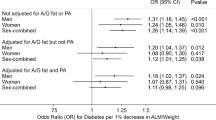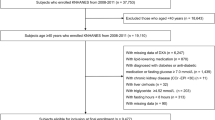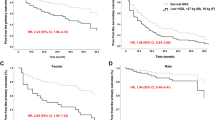Abstract
Background/Objectives
Older adults with known diabetes are vulnerable to accelerated loss of lean body mass. However, the relationship of hyperglycemia per se with lean body mass is not fully understood. We sought to examine the independent relationship of hyperglycemia with relative lean body mass in older persons without a reported history of diabetes.
Design
Cross-sectional nationally representative survey.
Setting
United States.
Participants
We studied U.S. adults >50 years without known diabetes (n=5434) in the National Health and Nutrition Examination Survey (1999–2004).
Measurements
In linear regression models, we studied the relationship of measured HbA1c (<5.0%, 5.0–5.4%, 5.5–5.9%, 6.0–6.4%, ≥6.5%) with percent lean body mass, measured by dual-energy x-ray absorptiometry, after accounting for potential confounders.
Results
Among older U.S. men and women, progressively higher HbA1c was associated with relatively lower total, appendicular, and trunk percent lean mass, independent of demographics and height (all p<0.05). Accounting for physical activity, C-reactive protein, and diabetes-related comorbidities (heart disease, peripheral arterial disease, arthritis, neuropathy, hip fracture, amputation, cancer, pulmonary disease), undiagnosed diabetes (i.e. HbA1c ≥6.5%) versus reference (<5.0%) in both men and women was associated with lower total (−3.5±0.8% and −2.9±0.8%), appendicular (−1.8±0.5% and −1.2±0.4%), and trunk percent lean mass (−1.2±0.4% and −1.3±0.5%), respectively (all p<0.05). Persons at increased risk for diabetes (i.e. HbA1c 6.0–6.4%) also had significant decrements at these sites versus reference.
Conclusions
Hyperglycemia is associated with relatively lower lean mass in a nationally representative population of older adults without history of diabetes. Future longitudinal studies are needed to investigate the relationship of hyperglycemia with the accelerated decline of skeletal muscle mass in older persons.
Similar content being viewed by others
References
Park SW, Goodpaster BH, Lee JS et al.; Health, Aging, and Body Composition Study. Excessive loss of skeletal muscle mass in older adults with type 2 diabetes. Diabetes Care 2009;32:1993–1997.
Janssen I, Heymsfield SB, Ross R. Low relative skeletal muscle mass (sarcopenia) in older persons is associated with functional impairment and physical disability. J Am Geriatr Soc. 2002;50:889–896.
Visser M, Kritehevsky SB, Goodpaster BH, et al. Leg muscle mass and composition in relation to lower extremity performance in men and women aged 70 to 79: the health, aging and body composition study. J Am Geriatr Soc 2002;50:897–904
Park SW, Goodpaster BH, Strotmeyer ES et al.; Health, Aging, and Body Composition Study. Decreased muscle strength and quality in older adults with type 2 diabetes: the health, aging, and body composition study. Diabetes 2006;55:1813–1818.
Kalyani RR, Tra Yolande, Yeh HC et al. Quadriceps strength, quadriceps power, and gait speed in older U.S. adults with diabetes: results from the National Health and Nutrition Examination Survey (NHANES), 1999–2002. J Am Geriatr Soc 2013; 61: 769–775.
Lee CG, Boyko EJ, Strotmeyer ES et al. Association between insulin resistance and lean mass loss and fat mass gain in older men without diabetes mellitus. J Am Geriatr Soc 2011; 59:1217–1224.
Lee CG, Boyko EJ, Barrett-Connor E et al.; Osteoporotic Fractures in Men (MrOS) Study Research Group. Insulin sensitizers may attenuate lean mass loss in older men with diabetes. Diabetes Care 2011; 34: 2381–2386.
Selvin E, Crainiceanu CM, Brancati FL et al. Short-term variability in measures of glycemia and implications for the classification of diabetes. Arch Intern Med. 2007 Jul 23; 167:1545–1551.
National Center for Health Statistics. Center for Disease Control and Prevention, National Health and Nutrition Examination Survey (NHANES) Questionnaire, Exam Protocol, and Analytic Guidelines [on-line]. Available at: http://www.cdc.gov/nchs/about/major/nhanes/datalink.htm. Accessed 9 April 2012.
Kelly TL, Wilson KE, Heymsfield SB. Dual energy X-Ray absorptiometry body composition reference values from NHANES. PLoS One 2009; 4: e7038.
Malik S, Wong ND, Franklin S et al. Cardiovascular disease in U.S. patients with metabolic syndrome, diabetes, and elevated C-reactive protein. Diabetes Care 2005; 28:690–693.
Kalyani RR, Saudek CD, Brancati FL et al. The association of diabetes, comorbidities, and hemoglobin Alc with functional disability in older adults: results from the National Health and Nutrition Examination Survey (NHANES), 1999–2006. Diabetes Care. 2010 May;33:1055–1060.
SAS Institute Inc. Chapter 83: The SURVEYFREQ Procedure. In SAS/STAT 9.2 User’s Guide. North Carolina, SAS Institute Inc, 2008, p. 6286–6364.
Selvin E, Steffes MW, Zhu H et al. Glycated hemoglobin, diabetes, and cardiovascular risk in nondiabetic adults. N Engl J Med 2010; 362:800–811.
Standards of medical care in diabetes-2013. Diabetes Care 2013; 36Suppl 1: S11–S66.
Schaap LA, Pluijm SM, Deeg DJ et al.; Health ABC Study. Higher inflammatory marker levels in older persons: associations with 5-year change in muscle mass and muscle strength. J Gerontol A Biol Sci Med Sci. 2009; 64:1183–1189.
Kumar V, Atherton P, Smith K et al. Human muscle protein synthesis and breakdown during and after exercise. J Appl Physiol 2009; 106:2026–2039.
Andersen H, Gjerstad MD, Jakobsen J. Atrophy of foot muscles: a measure of diabetic neuropathy. Diabetes Care. 2004; 27:2382–2385.
Rajabally YA. Neuropathy and impaired glucose tolerance: an updated review of the evidence. Acta Neurol Scand 2011; 124:1–8.
Halvatsiotis P, Short KR, Bigelow M et al. Synthesis rate of muscle proteins, muscle functions, and amino acid kinetics in type 2 diabetes. Diabetes 2002; 51:2395–2404.
Kelley DE, He J, Menshikova EV et al. Dysfunction of mitochondria in human skeletal muscle in type 2 diabetes. Diabetes 2002; 51:2944–2950.
Wijnhoven HA, Snijder MB, van Bokhorst-de van der Schueren MA et al. Region-specific fat mass and muscle mass and mortality in community-dwelling older men and women. Gerontology 2012; 58: 32–40.
Szulc P, Munoz F, Marchand F et al. Rapid loss of appendicular skeletal muscle mass is associated with higher all-cause mortality in older men: the prospective MINOS study. Am J Clin Nutr 2010; 91:1227–1236.
Newman AB, Kupelian V, Visser M et al. Strength, but not muscle mass, is associated with mortality in the health, aging and body composition study cohort. J Gerontol A Biol Sci Med Sci. 2006; 61:72–77.
Srikanthan P, Karlamangla AS. Relative muscle mass is inversely associated with insulin resistance and prediabetes. Findings from the third National Health and Nutrition Examination Survey. J Clin Endocrinol Metab 2011; 96:2898–2903.
Carson AP, Reynolds K, Fonseca VA et al. Comparison of A1C and fasting glucose criteria to diagnose diabetes among U.S. adults. Diabetes Care 2010; 33: 95–97.
Perkins BA, Olaleye D, Zinman B et al. Simple screening tests for peripheral neuropathy in the diabetes clinic. Diabetes Care 2001; 24:250–256.
Abdelhafiz A.H., Bailey C, Eng Loo B., Sinclair A. Hypoglycaemic symptoms and hypoglycaemia threshold in older people with diabetes-a patient perspective. J Nutr Health Aging 2013;10:899–802.
Author information
Authors and Affiliations
Corresponding author
Rights and permissions
About this article
Cite this article
Kalyani, R.R., Tra, Y., Egan, J.M. et al. Hyperglycemia is associated with relatively lower lean body mass in older adults. J Nutr Health Aging 18, 737–743 (2014). https://doi.org/10.1007/s12603-014-0538-9
Received:
Accepted:
Published:
Issue Date:
DOI: https://doi.org/10.1007/s12603-014-0538-9




